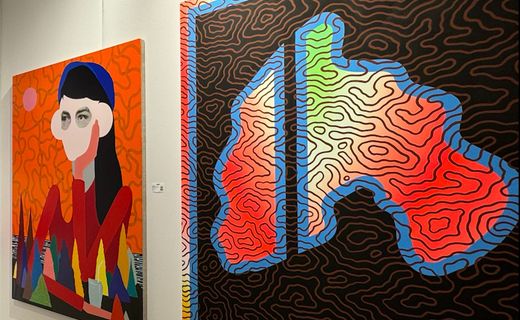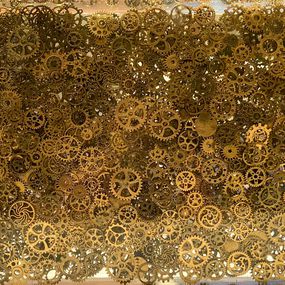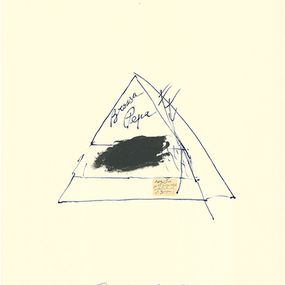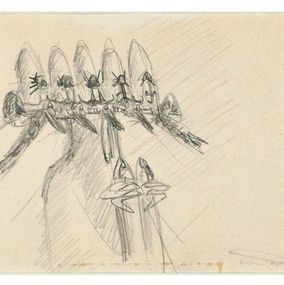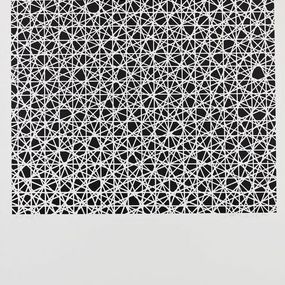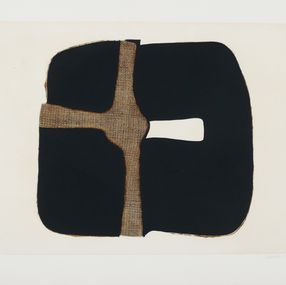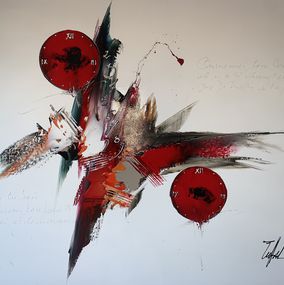

I think decoration is really beautiful. I think that’s what you have to do with painting. You have to decorate.
Biography
Born in 1936 in Malden, Massachusetts, USA, Frank Stella is based in New York. A painter considered the precursor of minimalism, he is one of the main representatives of Op Art and the shaped canvas. After studying art at the Phillips Academy in Andover, Massachusetts, and then history at Princeton University, he was influenced by the abstract expressionism of Pollock and Kline. It was only later that he would renounce the expressive use of paint and reject the lyricism of this movement. He worked on the oppositions between shapes and colors and is the inventor of “cut-out canvases." This led him to break the boundaries of classical geometry, and his paintings would evolve into true sculptures from the 1980s onward.
His first solo exhibition took place in 1960. There he presented his “Black paintings", already exhibited previously at the Museum of Modern Art in New York City during the exhibition “Sixteen Americans". This work was the culmination of his reflections on object painting and marked his break with abstract expressionism. Frank Stella's compositions are defined by the representation of regular black bands separated by thin white lines: here again the artist studies the opposition between forms and (non) colors and uses painting as an end and not as a means of expression or representation. Indeed, as Carl Andre, minimalist painter and sculptor, put it, “For Frank Stella, it proved necessary to paint bands. There is nothing else in his painting. Frank Stella is not interested in expression or sensitivity. He is interested in the necessities of painting. Its stripes are the paths the brush takes on the canvas. These paths lead only to painting.
This exhibition marks the starting point of the minimalism movement.
Frank Stella developed the concept of "cut-out canvases," the outline merging with the geometric shapes represented. He plays with colors. White, black, multicolored, the artist uses different supports, from aluminum to copper, even steel. His compositions are generally series. From the mid-1970s, he took a turn in his artistic approach as he began to work in relief, and was influenced by the Baroque movement.
Since the 1980s, Stella has been interested in sculpture and creates it almost exclusively.
Numerous exhibitions have been dedicated to him; he is one of the few artists to have been able to attend his own retrospective during his lifetime. Indeed, in 1970 and ten years later, exhibitions were dedicated to him at the Musée d'Art Moderne de la Ville de Paris. His sculpture "The Prince of Hamburg" was installed at the National Gallery of Art in Washington in 2001. A retrospective at the Whitney Museum in New York, USA, was dedicated to him in 2015.
Nationality
Categories
Artistic movements
Themes

Frank Stella
Print - 190 x 132 cm Print - 74.8 x 52 inch
€5,000

Frank Stella
Print - 41 x 55.6 x 0.1 cm Print - 16.1 x 21.9 x 0 inch
€6,899

Frank Stella
Print - 186.69 x 134.62 x 15.24 cm Print - 73.5 x 53 x 6 inch
€93,928



Frank Stella
Print - 177.8 x 165.7 x 0.8 cm Print - 70 x 65.25 x 0.3 inch
Price upon request

Frank Stella
Print - 167.6 x 132.1 x 0.3 cm Print - 66 x 52 x 0.1 inch
Sold


Exhibitions dedicated to Frank Stella
Discover the movements linked to Frank Stella
Discover similar artists
Posts about Frank Stella
Discover our selections of works by artists
Frank Stella is famous for pioneering minimalism and abstract art with his innovative use of geometric shapes, bold colors, and non-representational forms. His "Black Paintings" series and shaped canvases revolutionized postwar American art.
Frank Stella was a key figure in the Minimalist movement and also contributed to Abstract Expressionism and Post-Painterly Abstraction. His work is known for its geometric patterns and innovative use of shaped canvases.
Frank Stella's Black Paintings reject traditional representation, focusing on pure form and structure. Their geometric patterns and uniform black stripes emphasize the painting as an object, not a window to another reality.





